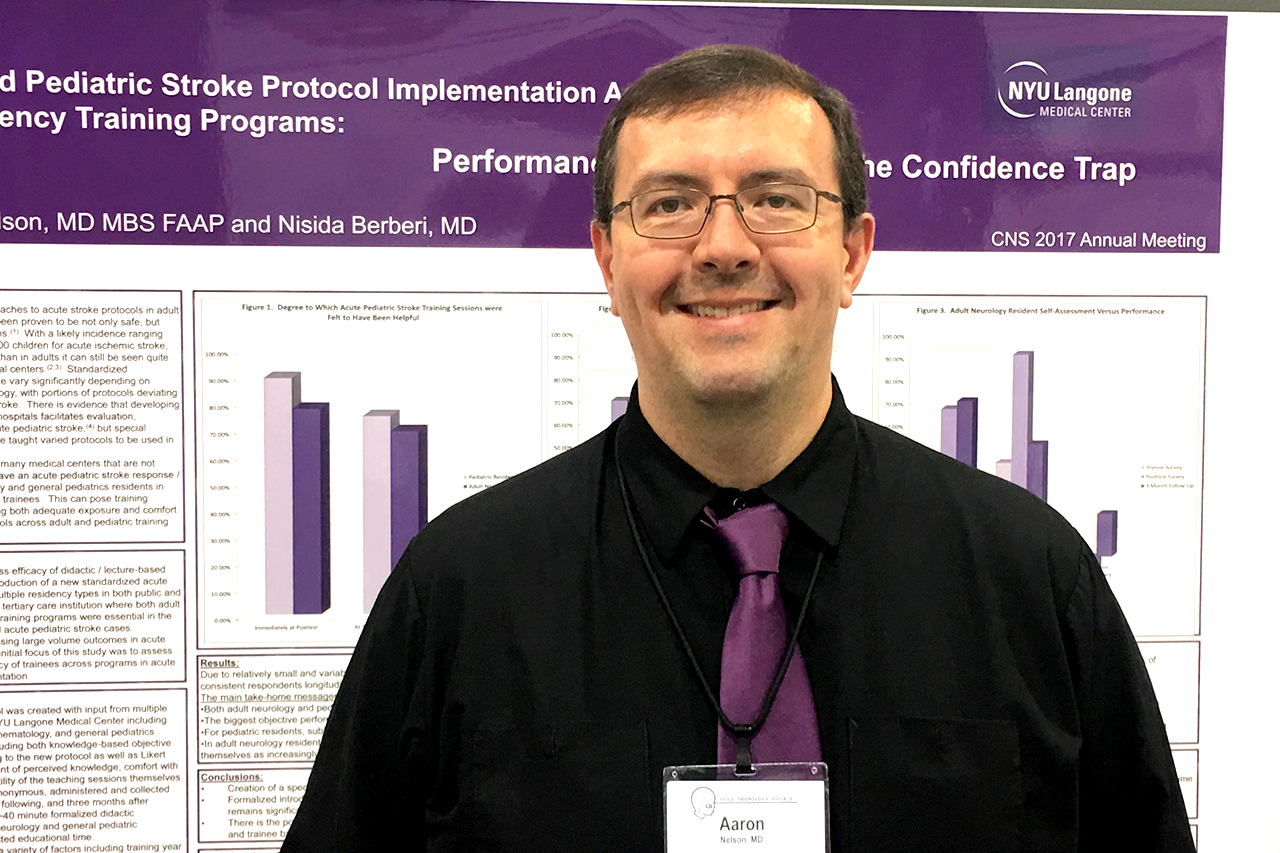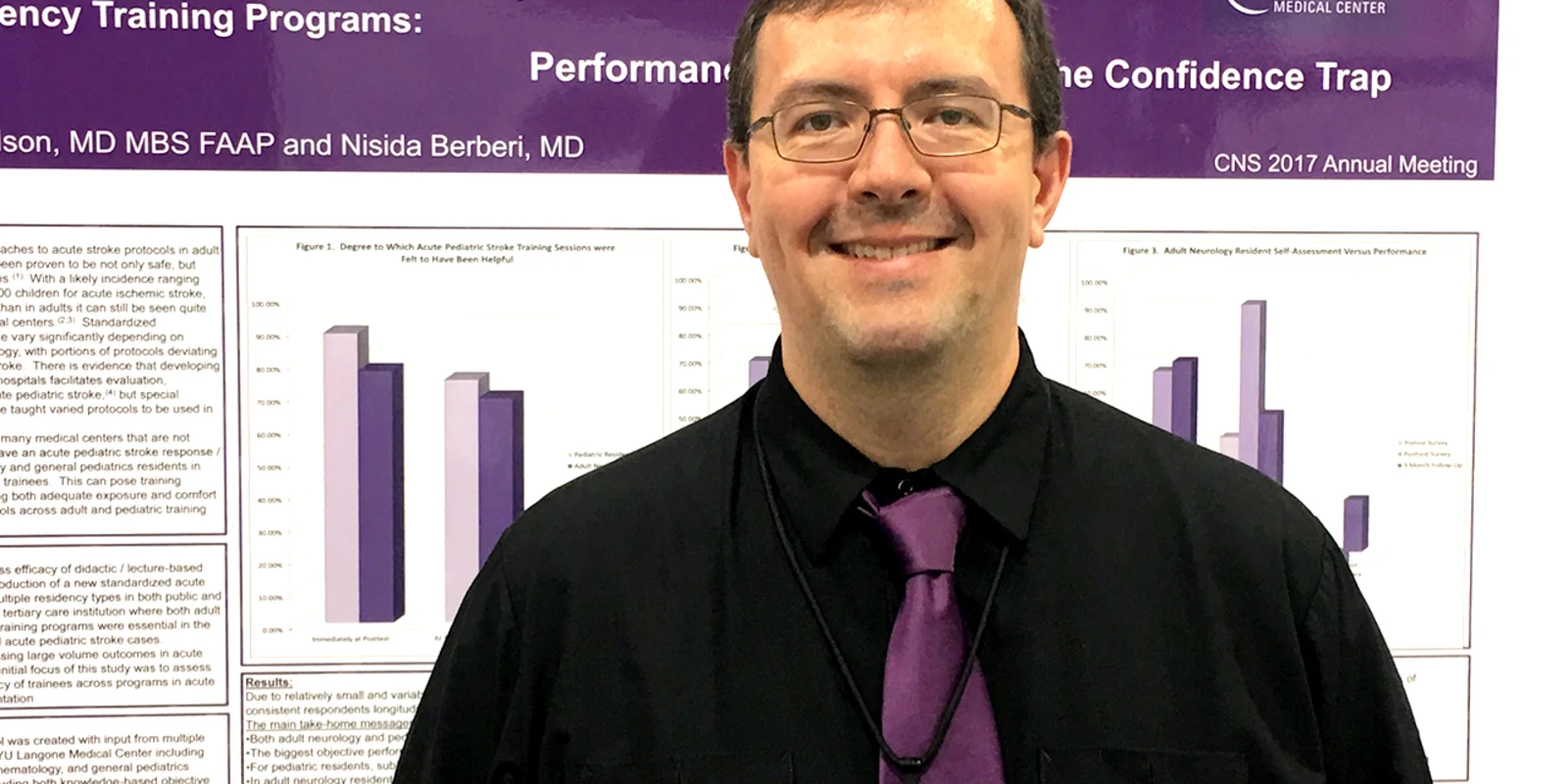
Name: Aaron Nelson, MD
Specialty: Neurology
Education: New York Presbyterian Hospital, NYU School of Medicine, New York Presbyterian Hospital, Rutgers-NJMS, Mayo Clinic School of Medicine
Areas of Expertise: Epilepsy, Neurology, Clinical neurophysiology, Electromyography, Headache medicine, Behavioral neurology / Neuropsychiatry, Sleep medicine, Neuromuscular medicine
Current Position: Director of Pediatric Epilepsy at Bellevue Hospital Center, Director of the Child Neurology Training Program at New York University
1. Why did you choose neurology?
In elementary school I learned to program, checking out library books and quickly becoming fascinated with networks — both organic and inorganic — and their emergent properties. Our public high school allowed access to university classes, and after a course on biology of the brain I was hooked! My zoological neuroscience focus in college eventually gave way to the intrigue of more complex human cognition and pathophysiology, prompting me to go to medical school. Once there I found clinical interactions with patients and their families much more rewarding than my original plans for basic research, leading me to pursue child neurology and eventually epilepsy.
2. What area of your specialty is changing most rapidly?
The running joke about neurologists used to be that we would diagnose problems but not fix them. So many rare and complex neurologic diseases in the past had minimal treatment beyond the supportive or palliative. We live in a golden age of advancements in genetics and molecular medicine; the last year alone there have been multiple game-changing treatments introduced for diseases where previously there were none (i.e. nusinersen for spinal muscular atrophy). We now have several enzyme replacement therapy trials ongoing for rare and previously untreatable neurodegenerative diseases just at my home institution.
3. What is the last journal article or piece of research that significantly changed your practice?
The past few years there have been several studies in top epilepsy and child neurology journals showing cheap and readily-available steroids to be much more effective for infantile epileptic spasms than previously thought — possibly equal to our prior first-line (incredibly expensive) therapy, ACTH. As someone who works with patients from all walks of life in both public and private institutions, having an option that is much less expensive, more readily available from neighborhood pharmacies, and much easier to administer (oral liquid versus daily injections) goes a long way when rapid initiation and consistency is critical for good long-term outcomes.
4. What are your research interests?
As a clinician-educator I’m actively involved in both clinical and academic research. Along with other faculty in our training programs I’ve looked at multiple teaching modalities including the initiation of objective structured clinical exams / standardized encounters in a state-of-the-art simulation center to both teach and assess professionalism. We’ve looked at the benefits and potential pitfalls of a teaching clinical protocols across differing residency types — and specifically how to address differences in confidence versus competency among trainees. I am also currently part of a CDC-funded grant spanning multiple institutions designed to characterize rare pediatric epilepsy throughout metropolitan New York.
5. Outside of your daily practice, do you have any personal or professional projects that you’re passionate about?
Currently I’m an editor in chief (in neurology-epilepsy) for StatPearls, a next-generation web- and app-based platform designed to democratize access to health-care knowledge both nationally and internationally while keeping pace with rapid technological innovations in education. It’s a cross-platform database of freely available, regularly updated PubMed-indexed review articles with associated questions, flashcards, lectures, and other continuing medical education opportunities that are crowd-sourced via collaborative efforts of experts within their fields and kept continually up to date. I have strong belief in the importance of access to both quality education and health care, and this could potentially impact both.
6. What is a common misconception that other clinicians have about neurology?
Aside from the previously-mentioned fact that neurology as a field has much more to offer in terms of interventions and therapeutics compared to even a decade ago, another common misconception imagines a relatively monolithic specialty when in fact there are many divisions within neurology — just as in internal medicine or pediatrics. I am board-certified in neurology with special qualification in child neurology, clinical neurophysiology, and epilepsy but that’s only the tip of the iceberg. In 2012, the AAN outlined at least 18 different ACGME and UCNS subspecialties of neurology; this only continues to grow as the field expands.
7. Who are your mentors?
Blessed with too long a list… As a student I was introduced to child neurology and mentored by leaders in the field at Mayo, Columbia, Einstein, and NYU. Moving from training at NYU to expanding public access to pediatric epilepsy care in New York through Bellevue, that shift would not have been possible without mentorship from my adult counterpart and chief, Dr. Anuradha Singh. As I’ve transitioned to directing the child neurology residency at NYU, Dr. John Wells (previous program director and now division head) provided both guidance and a safety net while remaining integrally involved in our program.
8. What’s the best advice you’ve ever received?
With regards to training and career path, the most important advice I got early-on during medical school was from the child neurologists at Mayo: specifically, to perform multiple away-electives at programs I was strongly considering for future training. It not only allowed me to make an informed decision and choose the right program for me personally but also to be taken seriously as a candidate coming from far away. In life: “Keep moving forward.” As Walt Disney said, “We keep moving forward, opening new doors, and doing new things, because we’re curious and curiosity keeps leading us down new paths.”
9. What has been your most gratifying moment of being a clinician?
In general, moments — no matter how big or small — when you know you’ve made someone’s life better. One moment that sticks out: Receiving a handwritten thank-you card from a boy who had come into the hospital seizing uncontrollably, in and out of a medically-induced coma for months. It was an incredibly long course and we got to know each other well by the time he was leaving. The sheer monumental effort and success implicit in his being able to write the note that day and walk out of the hospital can’t be overstated. It still hangs on my wall.
10. How do you unwind after a challenging day?
Well, I have two very young children, and most days I try to be there for daycare pick-up. That doesn’t leave a lot of time to transition from clinical practice to full-time parenting. Contemplative unwinding waits until after bedtime stories have been read and teeth brushed. As New Yorkers, we try to take advantage of all the city has to offer, so when we can coordinate a babysitter my wife and I love live music, stand-up comedy, theater, etc. When all else fails (at the risk of causing a flame-war) I’m an avid XBox gamer.
11. How do you motivate patients to do what’s best for their health?
Usually the most important thing to do is listen. If a patient (or in my case, sometimes their parent) is not doing what we think is best, there’s always a reason. Sometimes it’s a simple misunderstanding. Other times there are very real barriers in place that may not be obvious unless you ask. We have social workers who help parents from all backgrounds navigate what can otherwise be very complicated bureaucratic processes (insurance, education, specialized service, transportation, other support), and sometimes all that is needed is to sit down and take the time to explain things in language they understand.
12. What is the biggest challenge or obstacle in neurology?
Needless layers of bureaucracy. Systems designed to construct multiple barriers to good care in the hopes that patients or their physicians will fail to to navigate them — or at least there will be a high attrition rate so those who would otherwise pay save money in the short-term. Complicated insurance systems designed to maximize profits over individual patient care and outcomes. I have literally spent more than an hour on the phone (time away from other care) with insurance representatives simply to argue a single child with new-onset unexplained focal seizures actually needs MRI brain imaging. Who does that serve?
13. What are your favorite Doximity features and how have they helped your productivity (Dialer, DocNews, Career Navigator, e-Fax, etc.)?
I’m almost always on the go, so the features that are most useful are all in the mobile app. While I like e-Fax which goes with me anywhere, the feature I use the most is Dialer. While you can dial *67 to block your outgoing number, many physicians — and even patients / parents — now screen or refuse to answer blocked calls. Through the Dialer app, a number is still displayed, just not my personal one, so they answer. This has been enormously useful not only for me but our residents who have dedicated mobile phones for each clinical service.






